Table of Contents
- Introduction
- Editor’s Choice
- Global Medical Marijuana Market Overview
- Comparison of Market Penetration Rate for Marijuana and Other Substances
- Global Cannabis Market Statistics
- Revenue Generation Through Cannabis
- Patients in Medical Marijuana Statistics
- Medical Marijuana Sales Statistics
- Demographics of Medical Marijuana Users Statistics
- Medical Marijuana Usage Frequency Statistics
- Medical Marijuana Patent Holders Statistics
- Registered Medical Marijuana Clients’ Statistics
- Methods Most Used to Consume Regular Marijuana and Cannabis
- Medical Marijuana Cost Statistics
- Medical Marijuana Spending Statistics
- Marijuana Legalization Statistics
- Key Investments
- Regulations for Medical Marijuana
- Recent Developments
- Conclusion
- FAQs
Introduction
Medical Marijuana Statistics: Medical marijuana involves the use of cannabis and its compounds, particularly THC and CBD, for therapeutic purposes.
It has applications in managing chronic pain, nausea, appetite stimulation, muscle spasms, and some neurological conditions.
However, The legal status of medical marijuana varies by region, and it can be administered through inhalation, oral consumption, topical applications, or sublingually.
While research supports its efficacy for certain conditions, ongoing studies aim to further elucidate its benefits and risks.
Common side effects include dry mouth, dizziness, and changes in appetite or mood, with long-term use potentially posing additional risks.
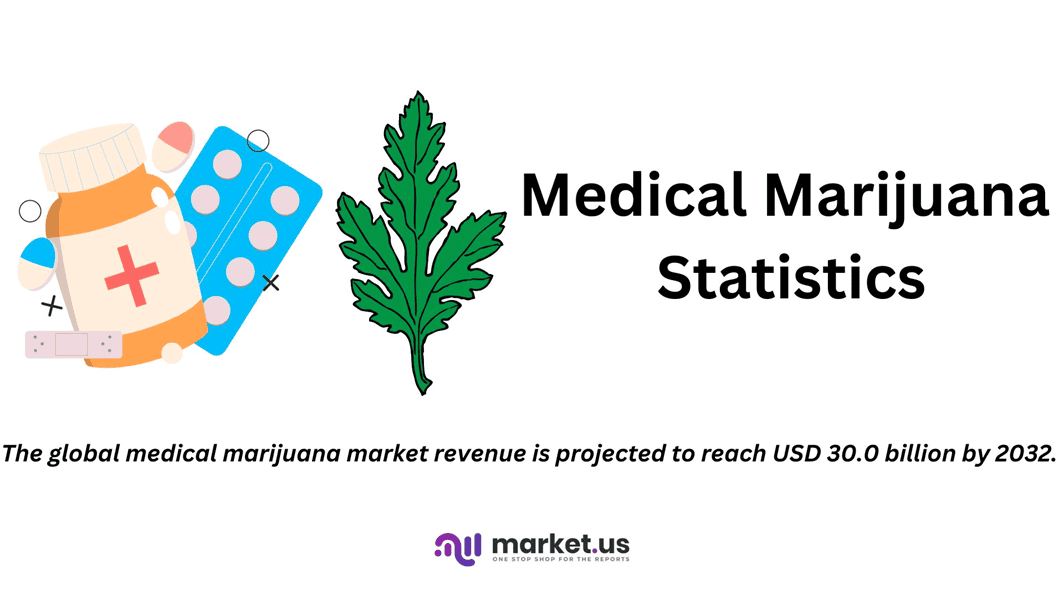
Editor’s Choice
- The global medical marijuana market revenue is projected to reach USD 30.0 billion by 2032.
- In the competitive landscape of the global medical marijuana market, Tilray Brands, Inc. holds the largest market share at 15%.
- The global medical marijuana market is predominantly concentrated in North America. Which holds a commanding 74.0% market share.
- As of 2022, the majority of medical marijuana patients in Colorado reported using it for severe pain, which accounts for 78.3% of patients.
- Global medical cannabis sales value is projected to reach USD 12.8 billion by 2027.
- As of 2019, AbbVie, a U.S.-based company, led the field of medical cannabis patents in the United States with 59 patents.
- In 2023, support for legalizing marijuana among U.S. adults reached a new high of 70%.
- In the United States, medical marijuana is legal in 38 states and several territories. It remains federally classified as a Schedule I substance, complicating nationwide standardization.
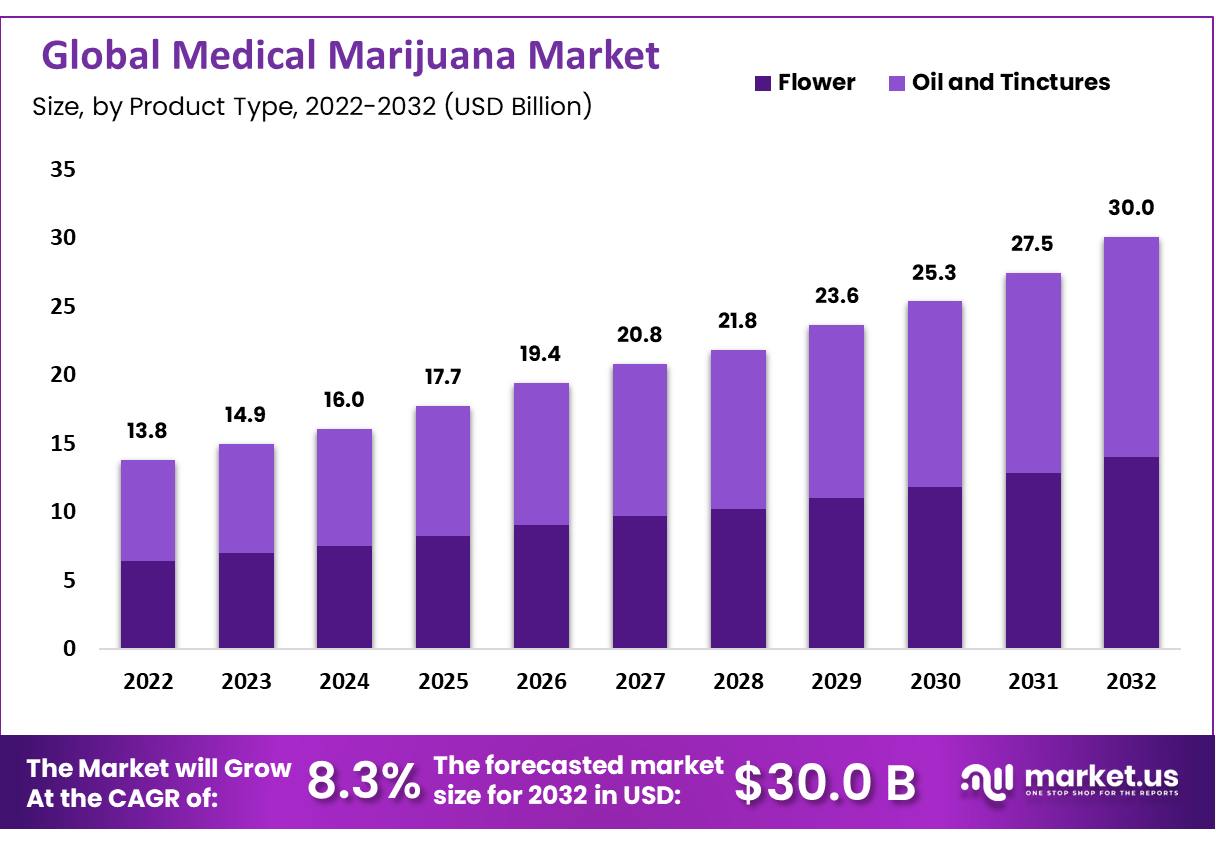
Global Medical Marijuana Market Overview
Global Medical Marijuana Market Size Statistics
- The global medical marijuana market has exhibited significant growth over the past decade at a CAGR of 8.3%, with a market value of USD 13.8 billion in 2022.
- This upward trajectory continued into 2023, reaching USD 14.9 billion.
- The market is projected to further expand, with estimates of USD 16.0 billion in 2024, USD 17.7 billion in 2025, and USD 19.4 billion in 2026.
- By 2027, the market is expected to attain a value of USD 20.8 billion. Escalating to USD 21.8 billion in 2028 and USD 23.6 billion in 2029.
- The forecast for 2030 predicts a market value of USD 25.3 billion. With substantial growth anticipated to USD 27.5 billion in 2031 and ultimately reach USD 30.0 billion by 2032.
- This steady increase underscores the growing acceptance and utilization of medical marijuana globally.
(Source: market.us)
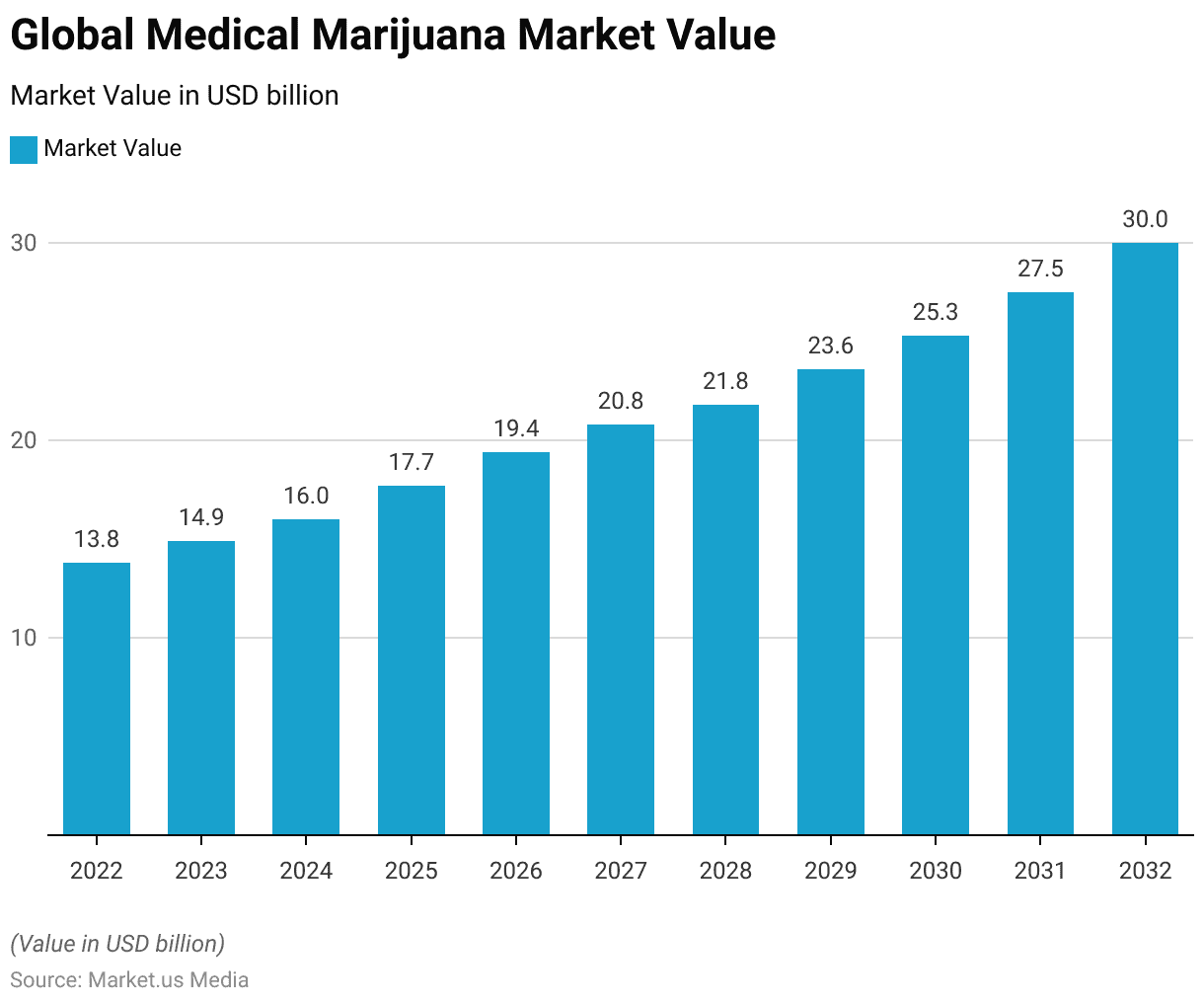
Competitive Landscape of Global Medical Marijuana Market Statistics
- In the competitive landscape of the global medical marijuana market, Tilray Brands, Inc. holds the largest market share at 15%, closely followed by Canopy Growth Corporation at 14%.
- Aurora Cannabis Inc. commands 13% of the market, while MedReleaf Corp. and G.W. Pharmaceuticals each account for 11%.
- Cannabis Sativa, Inc. and Medical Marijuana, Inc. each capture 10% of the market share.
- VIVO Cannabis Inc. holds an 8% share, which is also the proportion attributed to other key players in the industry.
- This distribution highlights the dominance of a few major companies while also indicating a significant presence of various other competitors in the market.
(Source: market.us)
Take advantage of our unbeatable offer - buy now!


Regional Analysis of Global Medical Marijuana Market Statistics
- The global medical marijuana market is predominantly concentrated in North America, which holds a commanding 74.0% market share.
- The Asia-Pacific (APAC) region accounts for 10.0% of the market, reflecting significant growth potential in this area.
- Both Europe and Latin America each capture 7.0% of the market share, indicating a balanced distribution across these regions.
- The Middle East and Africa (MEA) represent a smaller portion of the market, with a 2.0% share.
- This distribution underscores the strong foothold of North America in the medical marijuana industry while highlighting emerging opportunities in other regions.
(Source: market.us)
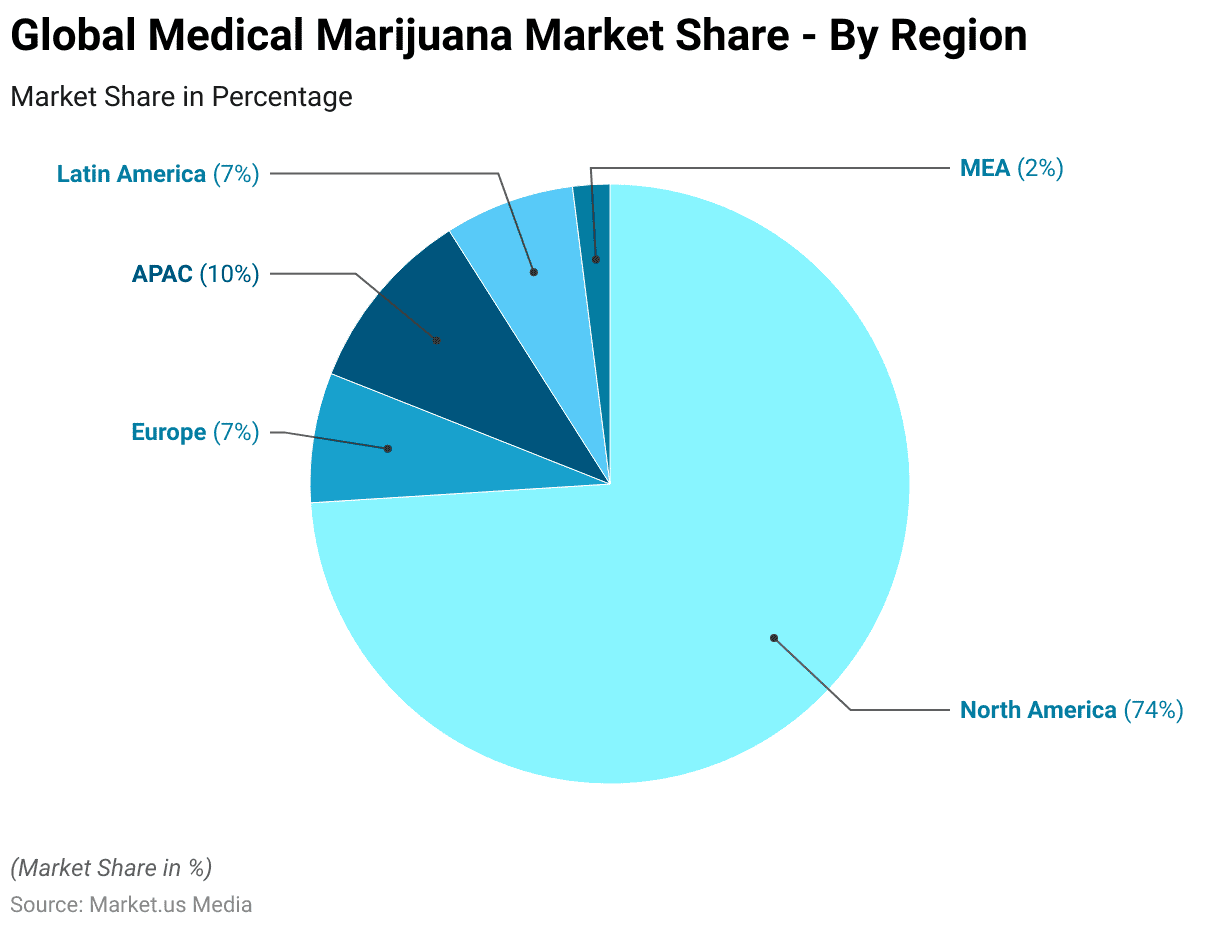
Comparison of Market Penetration Rate for Marijuana and Other Substances
- As of 2016, the expected market penetration rate shown in cannabis statistics in the United States was projected to be 20%, positioning it among other commonly used stimulants and substances.
- Alcohol and coffee held the highest penetration rates, each with 50% of the adult market.
- Painkillers followed with a penetration rate of 40%, reflecting their widespread use.
- Anti-depressants had a penetration rate of 25%, indicating significant usage among the population.
- Tobacco, with a 17% penetration rate, showed a lower level of market penetration compared to these other substances.
- The anticipated 20% market penetration rate for cannabis suggested its potential to become a substantial part of the stimulant and substance market in the future.
(Source: Statista)
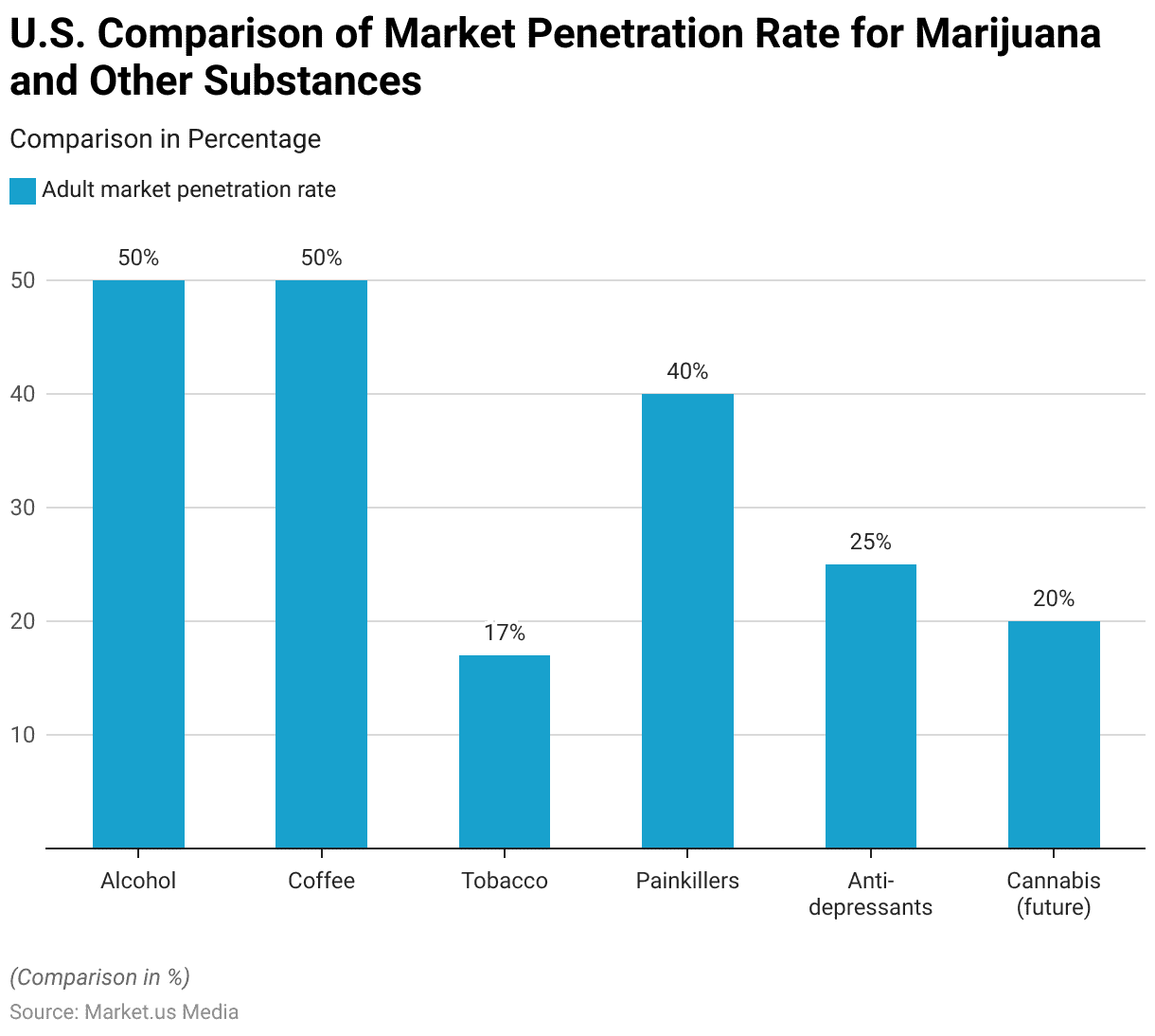
Global Cannabis Market Statistics
Global Cannabis Market Size
- The global cannabis market has experienced substantial growth from 2016 to 2028.
- In 2016, the market was valued at USD 7.67 billion. Which increased to USD 9.55 billion in 2017 and USD 11.9 billion in 2018.
- By 2019, the market value had reached USD 14.85 billion, continuing its upward trajectory to USD 18.24 billion in 2020.
- The market further expanded to USD 22.91 billion in 2021 and surged to USD 28.28 billion in 2022.
- In 2023, the market value is projected to rise to USD 33.88 billion. With anticipated growth to USD 39.86 billion in 2024.
- The market is expected to continue its rapid expansion. Reaching USD 46.26 billion in 2025, USD 53.13 billion in 2026, and USD 60.14 billion in 2027.
- By 2028, the global cannabidiol market is projected to attain a value of USD 67.16 billion.
- This consistent and robust growth reflects the increasing acceptance and utilization of cannabis products globally.
(Source: Statista)
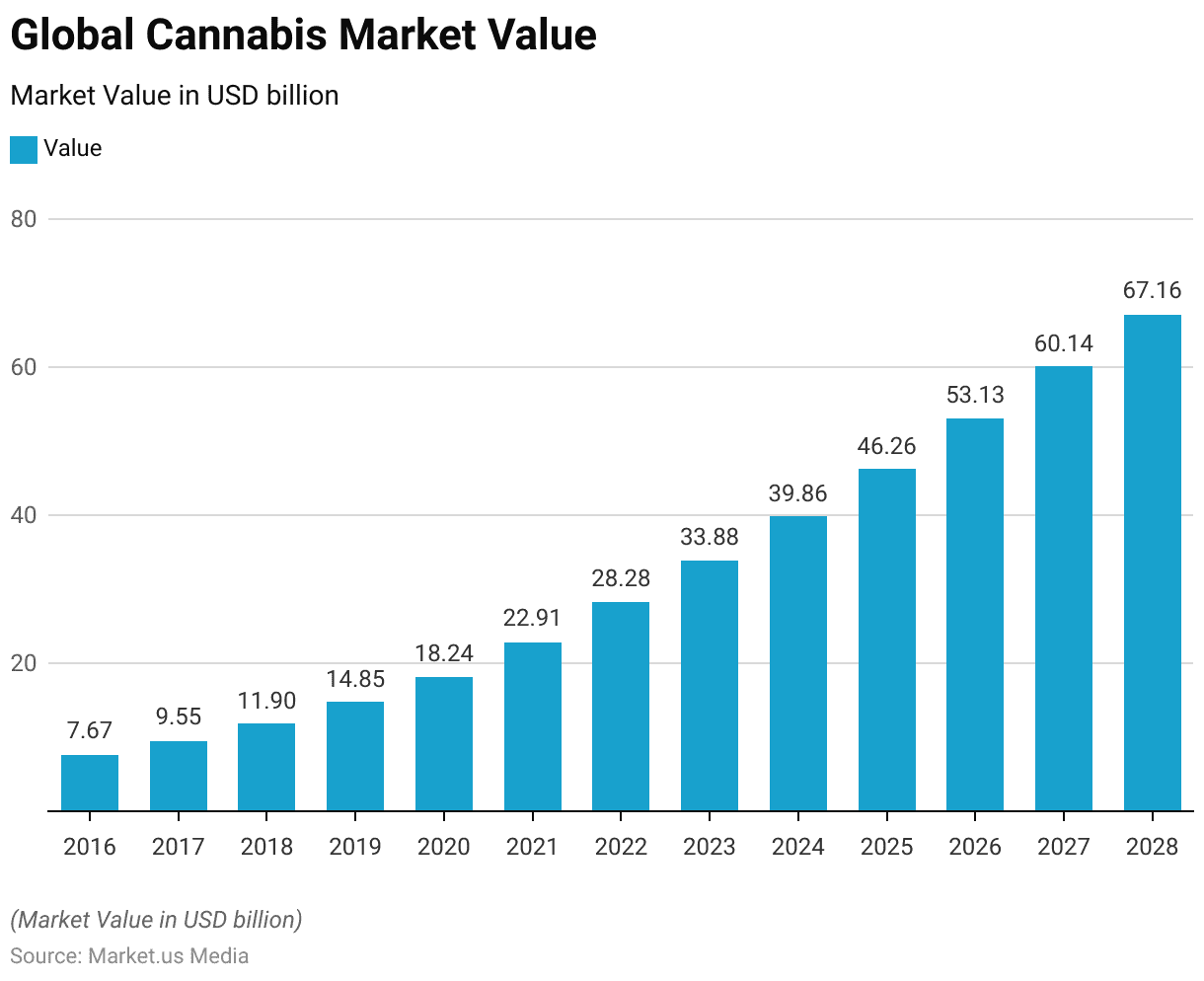
Revenue Generation Through Cannabis
2020-2024
- The average revenue per user (ARPU) for different types of cannabis companies has shown a notable increase from 2020 to 2024.
- In 2020, the ARPU for recreational cannabis was USD 28.69. While medical cannabis stood at USD 19.25, and therapeutic cannabis was USD 6.34.
- By 2021, these values rose to USD 36.48 for recreational, USD 23.58 for medical, and USD 7.92 for therapeutic cannabis.
- The trend continued in 2022, with ARPU reaching USD 45.42 for recreational. USD 28.43 for medical, and USD 9.72 for therapeutic cannabis.
- In 2023, the ARPU further increased to USD 54.75 for recreational. USD 33.31 for medical, and USD 11.60 for therapeutic cannabis.
- By 2024, these values were USD 64.64, USD 38.35, and USD 13.53, respectively.
(Source: Statista)
2025-2028
- The upward trajectory persisted in 2025, with recreational cannabis ARPU at USD 75.22, medical cannabis at USD 43.65, and therapeutic cannabis at USD 15.73.
- In 2026, the ARPU reached USD 86.56 for recreational, USD 49.22 for medical, and USD 18.02 for therapeutic cannabis.
- By 2027, the ARPU had risen to USD 98.23 for recreational. USD 54.66 for medical, and USD 20.36 for therapeutic cannabis.
- The trend is expected to continue, with projections for 2028 showing ARPU values of USD 109.80 for recreational. USD 60.05 for medical, and USD 22.68 for therapeutic cannabis.
- This consistent growth reflects increasing user spending across all categories of cannabis.
(Source: Statista)
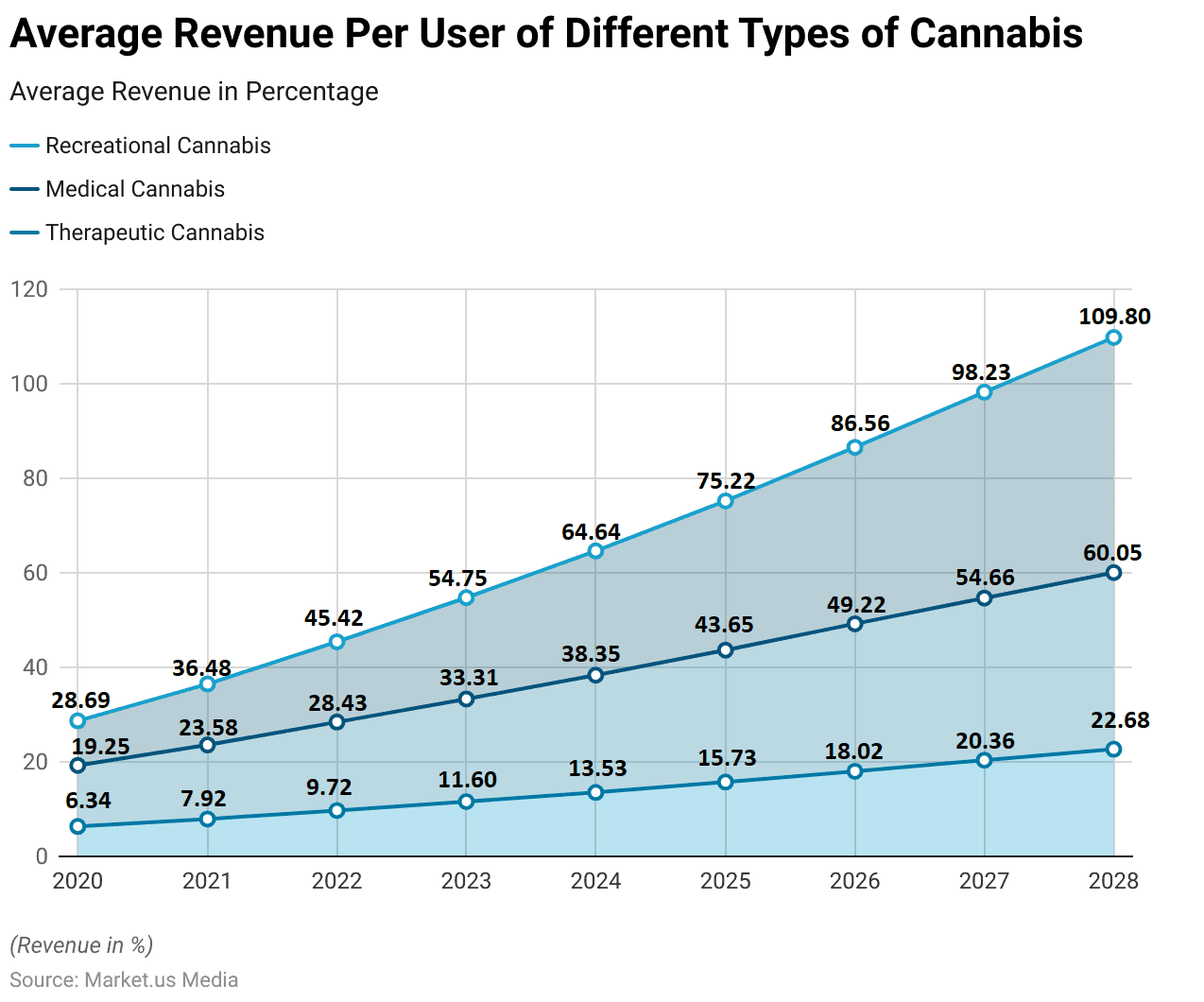
Patients in Medical Marijuana Statistics
Marijuana Patients – By Medical Condition Statistics
- As of 2022, the majority of medical marijuana patients in Colorado reported using it for severe pain, which accounts for 78.3% of patients.
- A significant portion, 21.3%, utilized medical marijuana as an alternative to opioids.
- Muscle spasms were cited by 16.9% of patients, while 15% used it to manage post-traumatic stress disorder (PTSD).
- Severe nausea was a condition for 13% of patients, and cancer-related use was reported by 3.4%.
- Smaller percentages of patients used medical marijuana for seizures (2.6%), autism spectrum disorder (0.9%), glaucoma (0.8%), cachexia (0.6%), and HIV/AIDS (0.5%).
- This data highlights the diverse range of medical conditions for which medical marijuana is sought in Colorado, with a predominant focus on pain management and opioid substitution.
(Source: Statista)

Medical Marijuana Sales Statistics
- Global medical cannabis sales are projected to demonstrate steady growth over the next few years.
- In 2023, the market is expected to achieve sales of USD 10.8 billion.
- This upward trend continues with an anticipated increase to USD 11.6 billion in 2024.
- By 2025, sales are forecasted to reach USD 12 billion, followed by USD 12.3 billion in 2026.
- The market is projected to further expand to USD 12.8 billion by 2027.
- This consistent growth trajectory underscores the rising acceptance and utilization of medical cannabis worldwide.
(Source: Statista)

Medical Marijuana Sales Value Statistics
- The medical cannabis sales value in Illinois has demonstrated notable fluctuations from 2018 to 2024.
- In 2018, sales reached USD 144.9 million, which increased significantly to USD 210.2 million in 2019.
- This upward trend continued into 2020, with sales climbing to USD 273.1 million and further rising to USD 295.8 million in 2021.
- However, in 2022, the sales value saw a decline to USD 269.5 million.
- This downward trend persisted, with sales falling to USD 232.9 million in 2023 and projected to further decrease to USD 213 million in 2024.
- This data indicates an initial period of rapid growth followed by a gradual decline in medical cannabis sales in Illinois.
(Source: Statista)
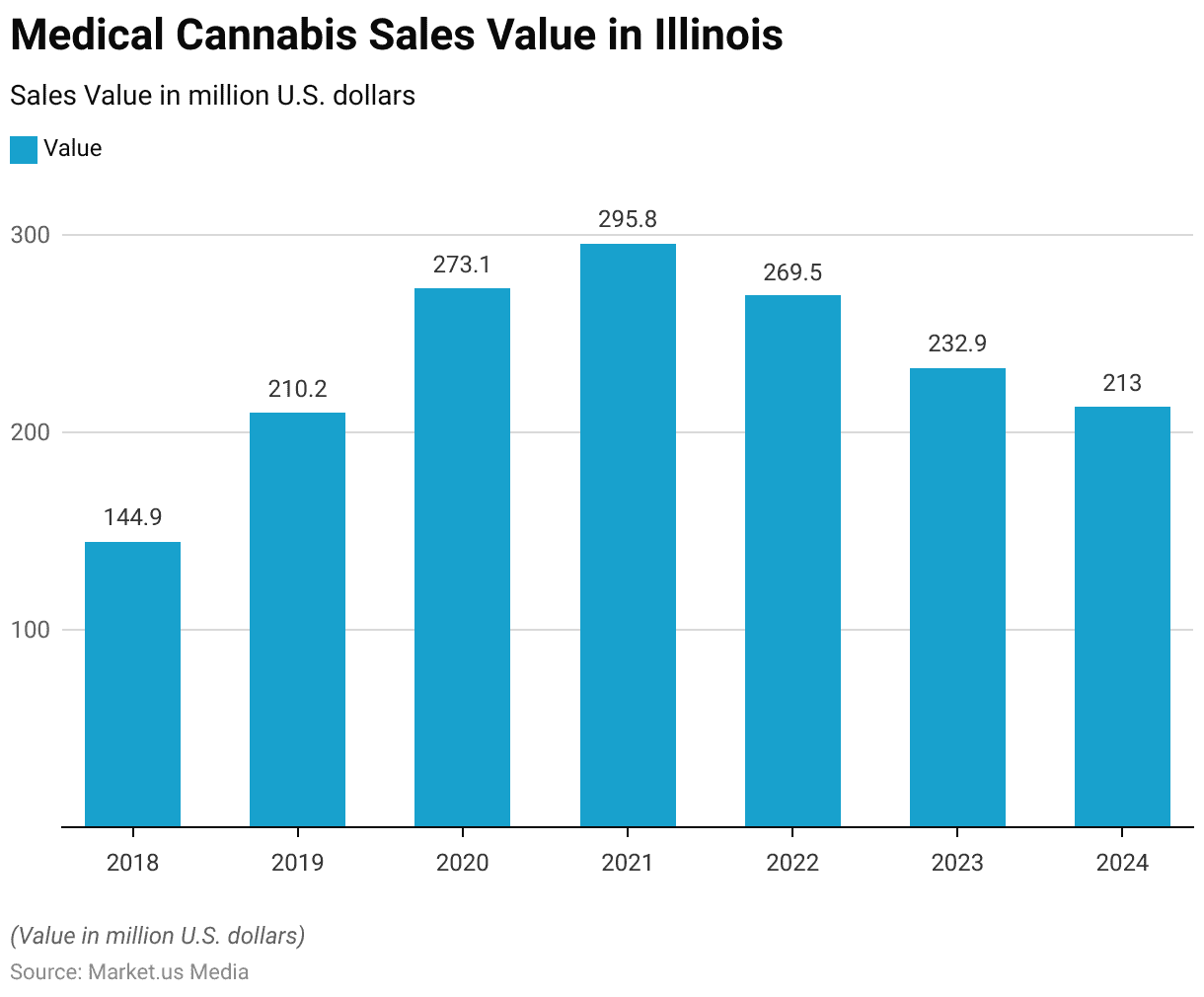
Demographics of Medical Marijuana Users Statistics
Generation
- Preferences for cannabis vapor pens vary significantly by generation and gender.
- Among Generation Z, 14.5% of males and 7.2% of females express a preference for using cannabis vapor pens.
- This preference increases notably among Millennials, with 33.1% of males and 15.8% of females favoring this method.
- For Generation X, the preference slightly decreases, with 13.5% of males and 7.7% of females using cannabis vapor pens.
- The lowest preference is observed among Baby Boomers. Where only 4.8% of males and 3.2% of females prefer this method of cannabis consumption.
- This data highlights a clear generational trend. Millennials leading in the use of cannabis vapor pens and a marked decline in preference as age increases.
(Source: Headset)
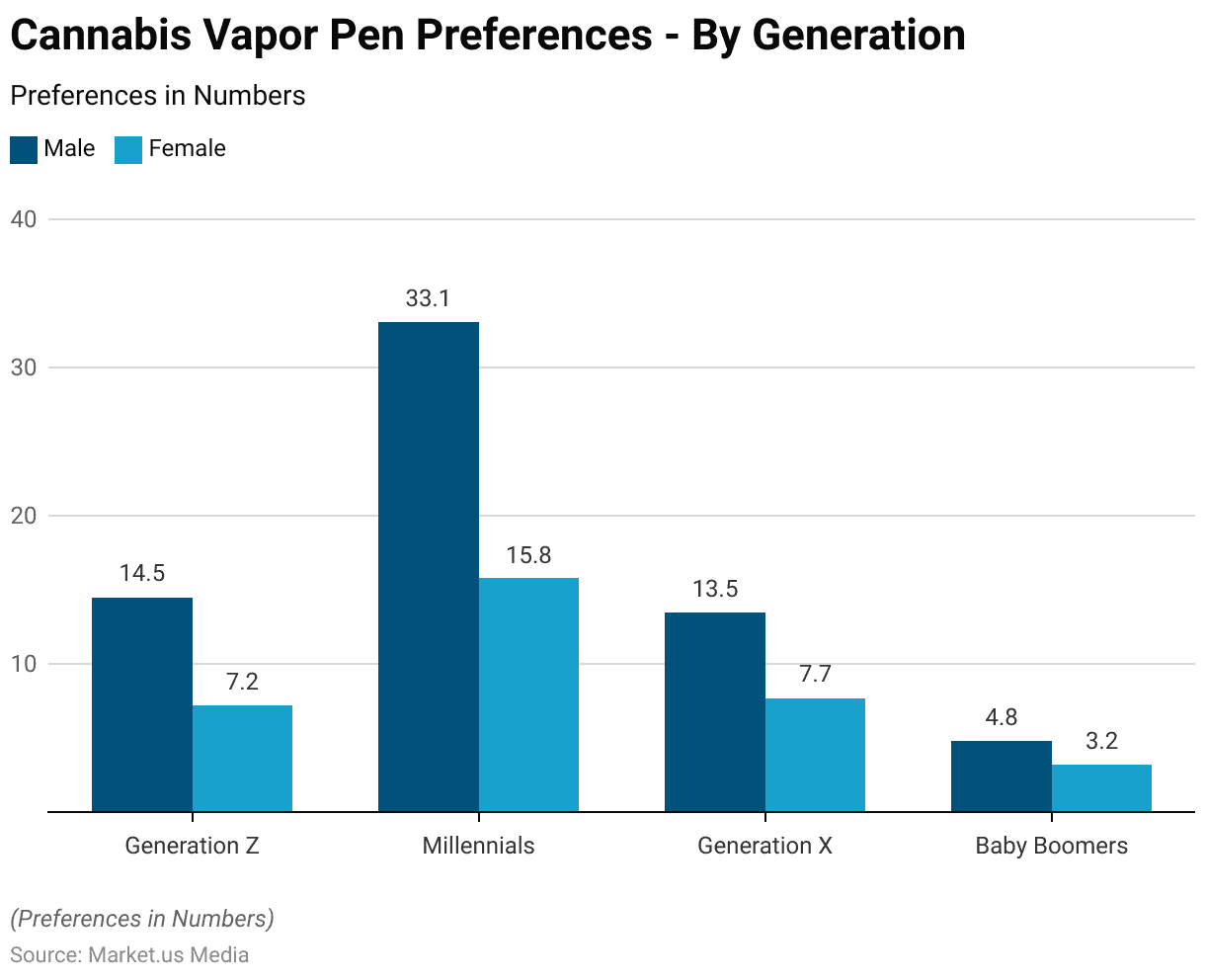
Age
- As of April 2024, the age distribution of medical marijuana patients registered in Oregon reveals a broad range of demographics.
- Patients aged 40 to 44 constitute the largest group, comprising 10.6% of the total.
- This is closely followed by those aged 35 to 39 and 65 to 69. Each represents 10% and 10.1% of patients, respectively.
- The age group 60 to 64 accounts for 9.9%, while those aged 45 to 49 make up 9.7%.
- Patients aged 50 to 54 and 55 to 59 each represent approximately 8.3% and 8.1% of the total, respectively.
- Those in the 30 to 34 age group constitute 8.2%, and those aged 70 to 74 account for 7.8%.
- The age groups 25 to 29 and 21 to 24 represent 5.5% and 2.7% of the patient population, respectively.
- Younger patients are less common, with those aged 18 to 20 comprising 3.6%, those aged 75 to 79 making up 4.1%, and those aged 80 and above accounting for 1%.
- The youngest patients, aged 0 to 10 and 11 to 15, are the smallest groups. Representing just 0.1% and 0.2% of the total, respectively.
- This distribution indicates a diverse patient base, with a significant concentration in middle-aged and older adults.
(Source: Statista)
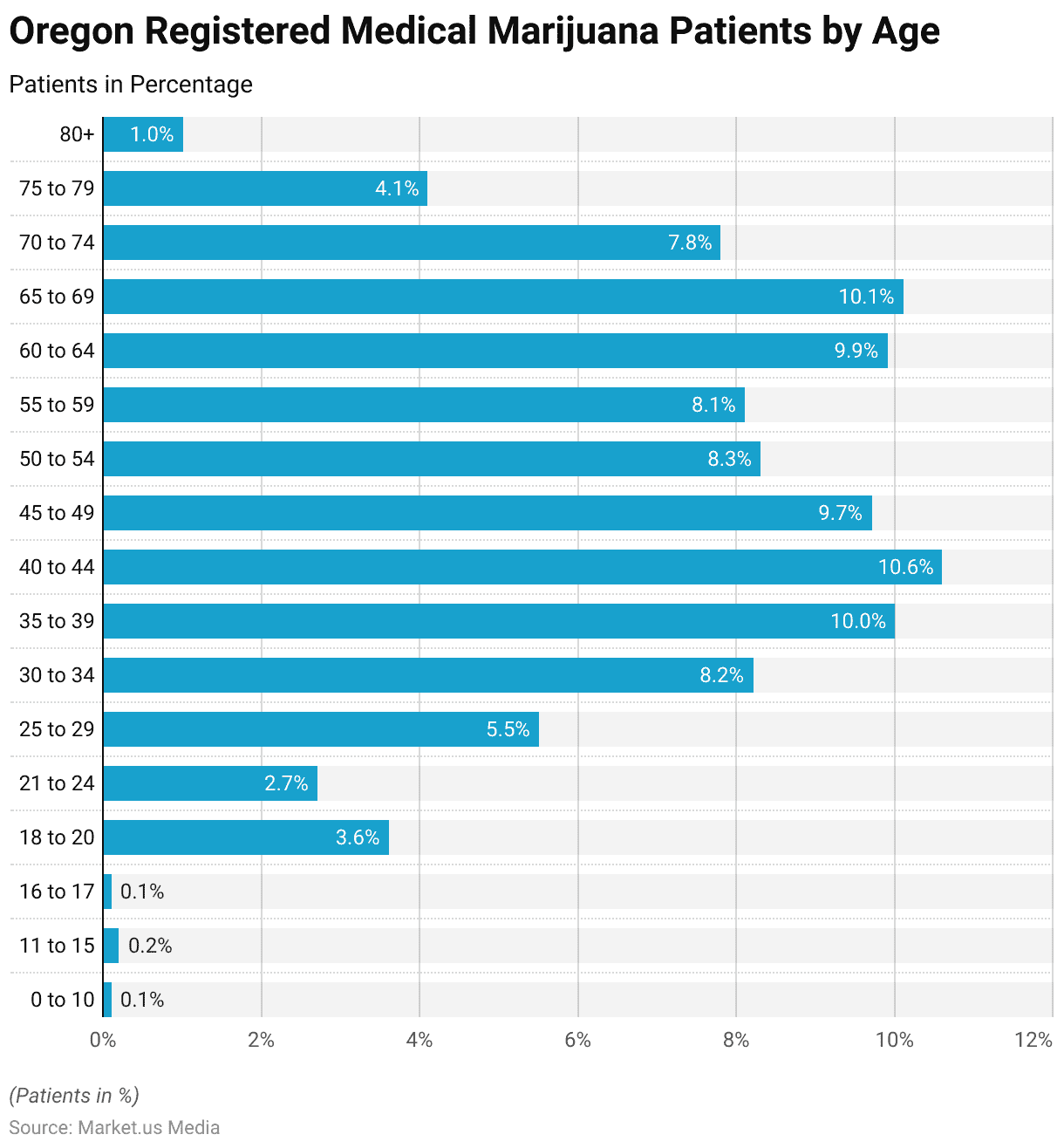
Gender
- In 2016, the openness of U.S. medical marijuana patients about their cannabis use varied slightly by gender.
- Among female patients, 13.9% did not agree with being open about their cannabis use, while 14.5% of male patients shared this sentiment, resulting in an overall 14.3% of patients who did not agree.
- A small percentage of patients, 2% of females and 2.2% of males indicated that the question did not apply to them, totaling 2.1% across both genders.
- A larger proportion, 40.6% of females and 38.7% of males, somewhat agreed with being open about their cannabis use, averaging 39.4% overall.
- The majority of patients strongly agreed with openness about their cannabis use, with 43.5% of females and 44.6% of males, leading to an overall strong agreement rate of 44.2%.
- This data illustrates a general trend of openness among medical marijuana patients, with a slight predominance among male patients.
(Source: Statista)
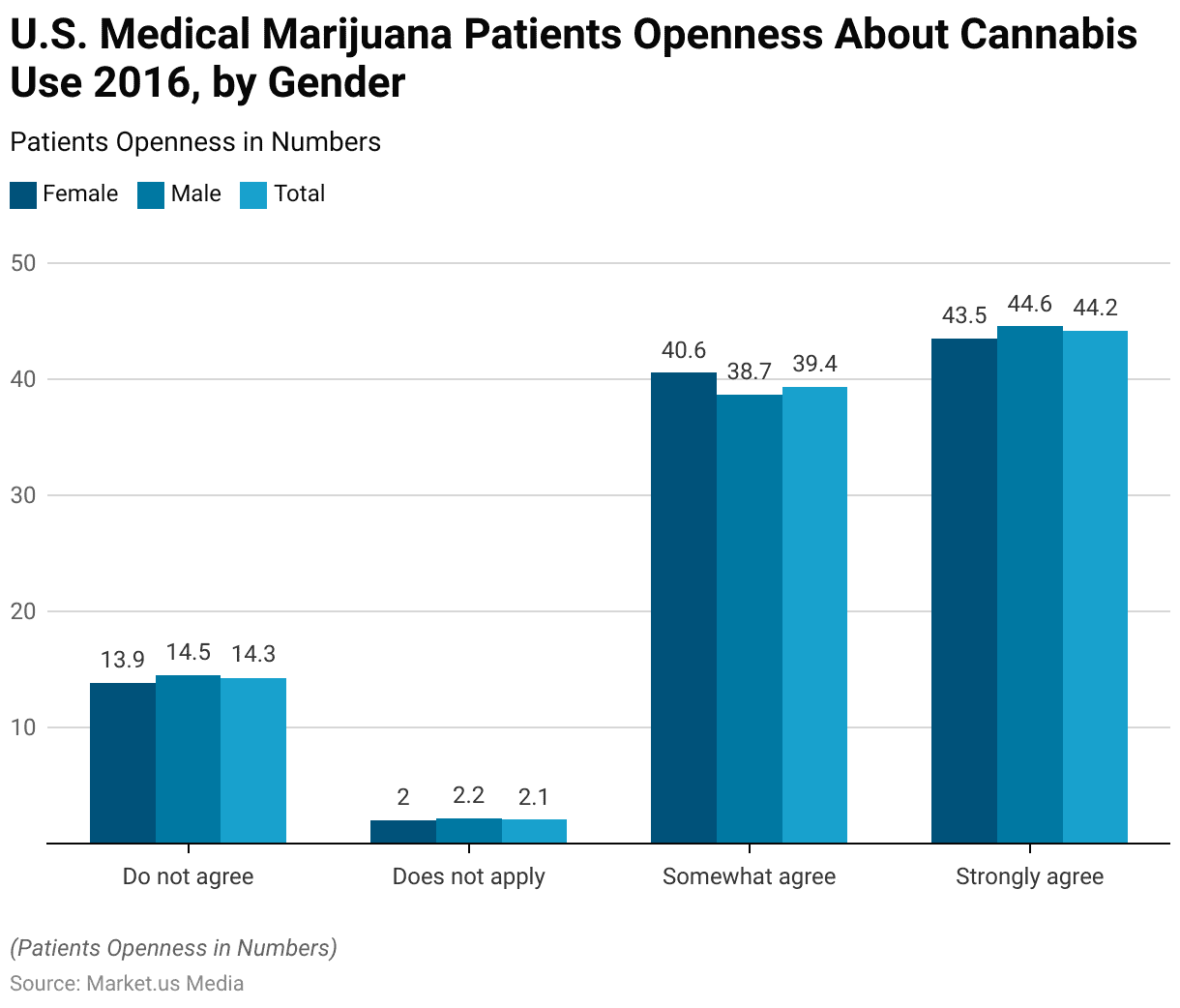
Medical Marijuana Usage Frequency Statistics
Monthly
- The number of people in the United States who reported using marijuana in the past month has shown a consistent upward trend from 2009 to 2022.
- In 2009, approximately 16.8 million individuals used marijuana, a number that increased to 17.4 million in 2010 and 18.1 million in 2011.
- This upward trajectory continued, with 18.9 million users in 2012 and 19.8 million in 2013.
- By 2014, the number had risen to 22.2 million, and it remained steady in 2015 with 22.2 million users.
- The following years saw further increases: 24.0 million in 2016, 26.0 million in 2017, and 27.7 million in 2018.
- The number of users surged to 31.6 million in 2019 and 32.8 million in 2020.
- This growth continued into 2021, with 37.0 million users, and reached a peak of 42.3 million in 2022.
- This data highlights the growing prevalence of marijuana use over the past decade in the U.S.
(Source: Statista)
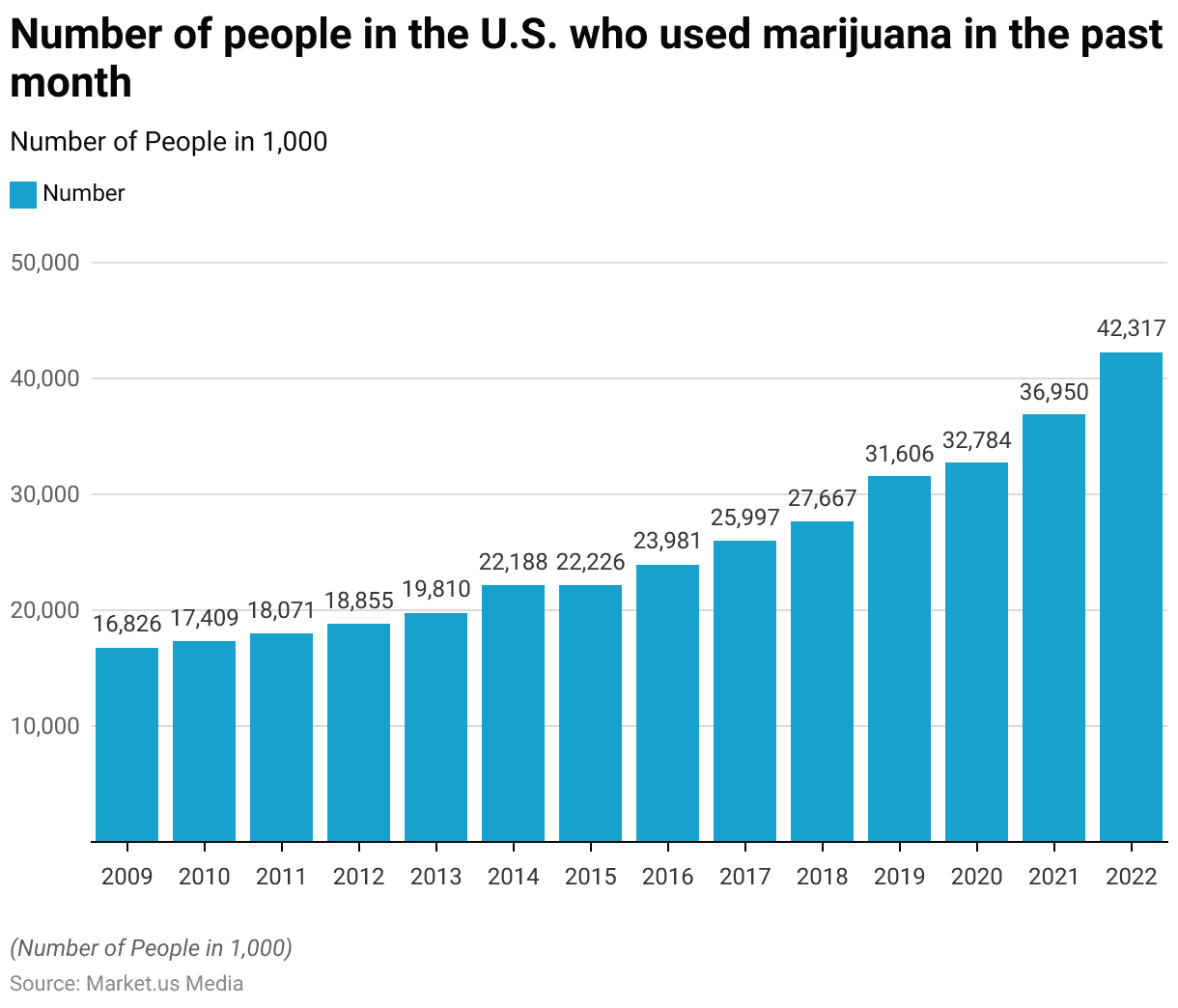
Medical Marijuana Patent Holders Statistics
- As of 2019, AbbVie, a U.S.-based company, led the field of medical cannabis patents in the United States with 59 patents.
- Sanofi, also from the U.S., followed with 39 patents, while Merck held 35 patents.
- Bristol-Myers Squibb, another U.S. company, had 34 patents.
- G.W. Pharmaceuticals from the U.K. owned 28 patents, making it the leading non-U.S. entity in this space.
- Pfizer, based in the U.S., held 25 patents.
- The Hebrew University of Jerusalem in Israel had 19 patents, followed by Roche from Switzerland with 17 patents.
- The University of Connecticut in the U.S. possessed 16 patents, and the U.S. Department of Health and Human Services had 13 patents.
- This distribution underscores the significant contributions of both U.S. and international organizations to the development and protection of medical cannabis innovations.
(Source: Statista)

Registered Medical Marijuana Clients’ Statistics
2015-2019
- The quarterly number of registered medical marijuana clients in Canada experienced significant growth from April 2015 to December 2019.
- Beginning with 23,930 clients in April-June 2015, the figures steadily increased, reaching 30,537 in July-September 2015 and 39,668 in October-December 2015.
- This growth trend continued into 2016, with 53,649 clients in January-March, 75,166 in April-June, and 98,460 in July-September, culminating in 129,876 by October-December.
- The upward trajectory persisted in 2017, with 167,754 clients registered in January-March, 201,398 in April-June, 235,621 in July-September, and 269,502 in October-December.
- In 2018, the number of registered clients continued to climb, reaching 296,702 in January-March, 330,344 in April-June, 342,103 in July-September, and 353,642 in October-December.
- The peak was observed in 2019, with 355,302 clients in January-March, 363,917 in April-June, and 369,614 in July-September, before a slight decrease to 358,864 by October-December.
2020-2023
- The year 2020 saw fluctuations, with 329,038 clients in January-March, dropping to 303,221 in April-June, then rising again to 377,024 in July-September, before declining to 321,539 by October-December.
- The downward trend continued in 2021, starting with 292,399 clients in January-March, 272,379 in April-June, 264,734 in July-September, and 257,059 in October-December.
- In 2022, the number of registered clients further decreased, with 247,548 in January-March, 237,275 in April-June, 232,105 in July-September, and 224,474 in October-December.
- This declining trend extended into 2023, with 212,700 clients in January-March, 203,933 in April-June, 188,301 in July-September, and 183,909 by October-December.
This data illustrates a significant rise in registered clients from 2015, peaking in 2019, followed by a gradual decline in subsequent years.
(Source: Statista)

Methods Most Used to Consume Regular Marijuana and Cannabis
- In Canada, the methods most commonly used to consume marijuana and cannabis saw some changes between 2021 and 2022.
- Smoking remained the most prevalent method, although its usage decreased slightly from 74% in 2021 to 70% in 2022.
- Eating cannabis in food maintained a steady popularity, with 52% of users employing this method in both years.
- The use of vape pens or e-cigarettes for vaporizing cannabis saw an increase, rising from 28% in 2021 to 31% in 2022.
- Conversely, the ingestion of cannabis oil declined from 22% in 2021 to 18% in 2022.
- Drinking cannabis-infused beverages remained consistent at 16% in both years.
- Vaporizing using a vaporizer was also stable at 10% for both years.
- The application of cannabis to the skin dropped from 9% in 2021 to 7% in 2022, while dabbing remained constant at 6% in both years.
- This data highlights the evolving preferences and stability in certain consumption methods among cannabis users in Canada.
(Source: Statista)

Medical Marijuana Cost Statistics
- As of October 2022, the average price per ounce of high-quality marijuana varied significantly across select U.S. states.
- The highest price was observed in the District of Columbia, at USD 590.27 per ounce. Illinois followed with an average price of USD 351.63, and Oklahoma at USD 341.50.
- In Connecticut, the price was USD 331.46, while Texas reported an average of USD 322.95 per ounce.
- The U.S. average stood at USD 318.74.
- Florida and Arizona had prices of USD 298.64 and USD 296.62, respectively.
- Michigan’s average was USD 289.13, followed by New Mexico at USD 283.33.
- Prices continued to decrease in Nevada at USD 270.90, Montana at USD 266.15, and California at USD 258.89.
- Colorado and Washington reported average prices of USD 241.58 and USD 233.97, respectively, with Oregon having the lowest price among the listed states at USD 210.21 per ounce.
- This data highlights the substantial variation in marijuana pricing across different regions in the United States.
(Source: Statista)
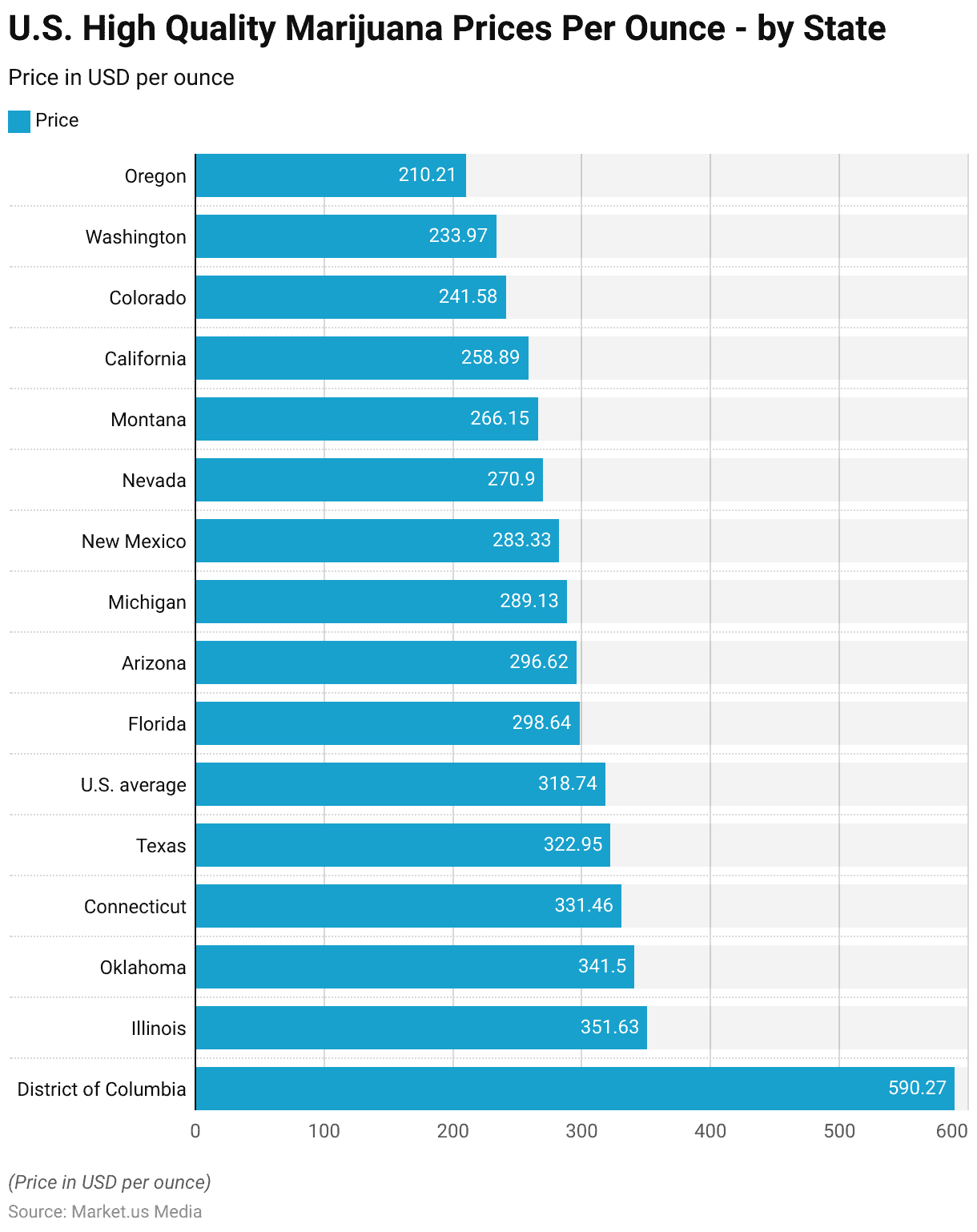
Medical Marijuana Spending Statistics
- As of 2016, spending patterns on cannabis products among medical marijuana users in the U.S. varied by age group.
- Among those aged 18-24, 30.2% spent $150 or more per month, 52.4% spent between $50 and $150, and 17.5% spent less than $50.
- In the 25-34 age group, 27.9% spent $150 or more, 51.3% spent $50-$150, and 20.8% spent less than $50.
- For users aged 35-44, 31.9% spent $150 or more, 47% spent $50-$150, and 21.1% spent less than $50.
- In the 45-54 age group, 21.3% spent $150 or more, 52.1% spent $50-$150, and 26.6% spent less than $50.
- Among those aged 55-64, 22.1% spent $150 or more, 48.3% spent $50-$150, and 29.7% spent less than $50.
- Finally, for users aged 65 years or older, 15.7% spent $150 or more, 55.7% spent $50-$150, and 28.6% spent less than $50.
- This data highlights a trend where younger age groups tend to spend more on cannabis products, while older age groups are more likely to spend between $50 and $150 per month.
(Source: Statista)
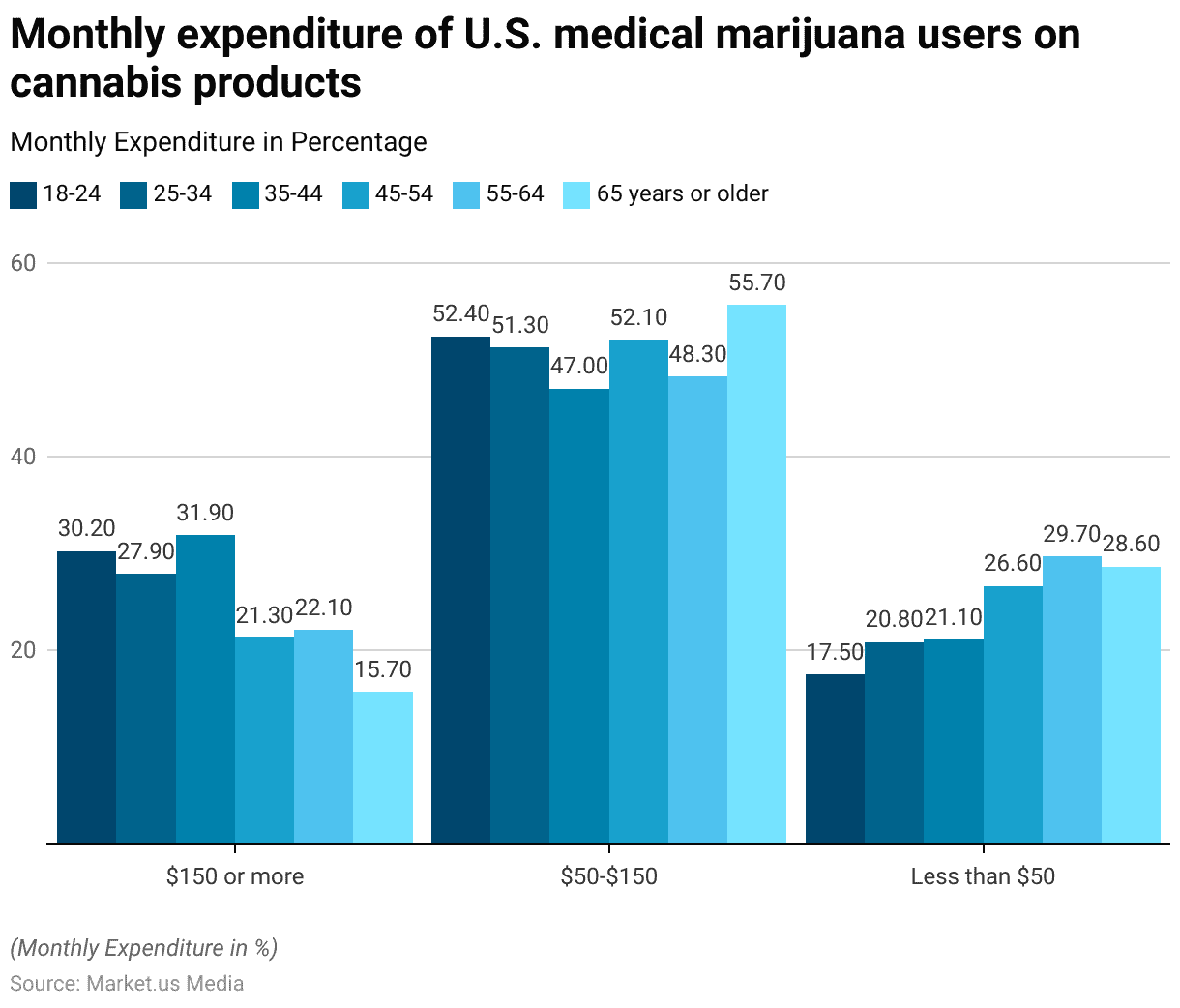
Marijuana Legalization Statistics
General Opinion
- Opinions on the legalization of marijuana in the U.S. reveal a range of perspectives among respondents.
- According to the data, 19% of respondents strongly favor legalization, while 14% somewhat favor it.
- A portion of the population, 11%, remains neutral, neither for nor against legalization.
- On the opposing side, 16% somewhat oppose legalization, and a significant 40% strongly oppose it.
- Additionally, 1% of respondents are uncertain, indicating they don’t know or have no opinion on the matter.
- This distribution highlights the polarized views on marijuana legalization, with a notable portion of the population expressing strong opposition.
(Source: Statista)

Legalizing Opinion
2003-2013
- From 2003 to 2013, American opinions on the legalization of marijuana have shifted significantly.
- In November 2003, only 34% of Americans supported legalization, while 64% were opposed, and 2% had no opinion.
- By October 2005, support had slightly increased to 36%, with 60% still opposed and 4% undecided.
- In October 2009, support rose to 44%, with opposition at 54% and 2% expressing no opinion.
- The trend continued upward in October 2010, with 46% in favor and 50% against, and by October 2011, support reached 50%, surpassing opposition, which fell to 46%, with 3% undecided.
- November 2012 saw a slight dip in support to 48%, with 50% opposed and 1% unsure.
- However, by October 2013, a significant shift occurred, with 58% supporting legalization, 39% opposing, and 3% undecided.
2014-2021
- In October 2014, support slightly decreased to 51%, with 47% against and 2% with no opinion.
- The following year, in October 2015, support returned to 58%, with opposition at 40% and 2% undecided.
- By October 2016, support reached 60%, with 39% opposed and 1% unsure. In October 2017, support increased further to 64%, with 34% against and 2% undecided.
- The trend continued in October 2018, with 66% in favor, 32% opposed, and 2% undecided, maintaining this level of support through May 2019 and October 2019, with slight variations in opposition and undecided percentages.
- By September-October 2020, support peaked at 68%, with 32% opposed and no undecided respondents.
- This level of support remained consistent in October 2021, indicating a substantial and growing acceptance of marijuana legalization over the past two decades.
(Source: Statista)
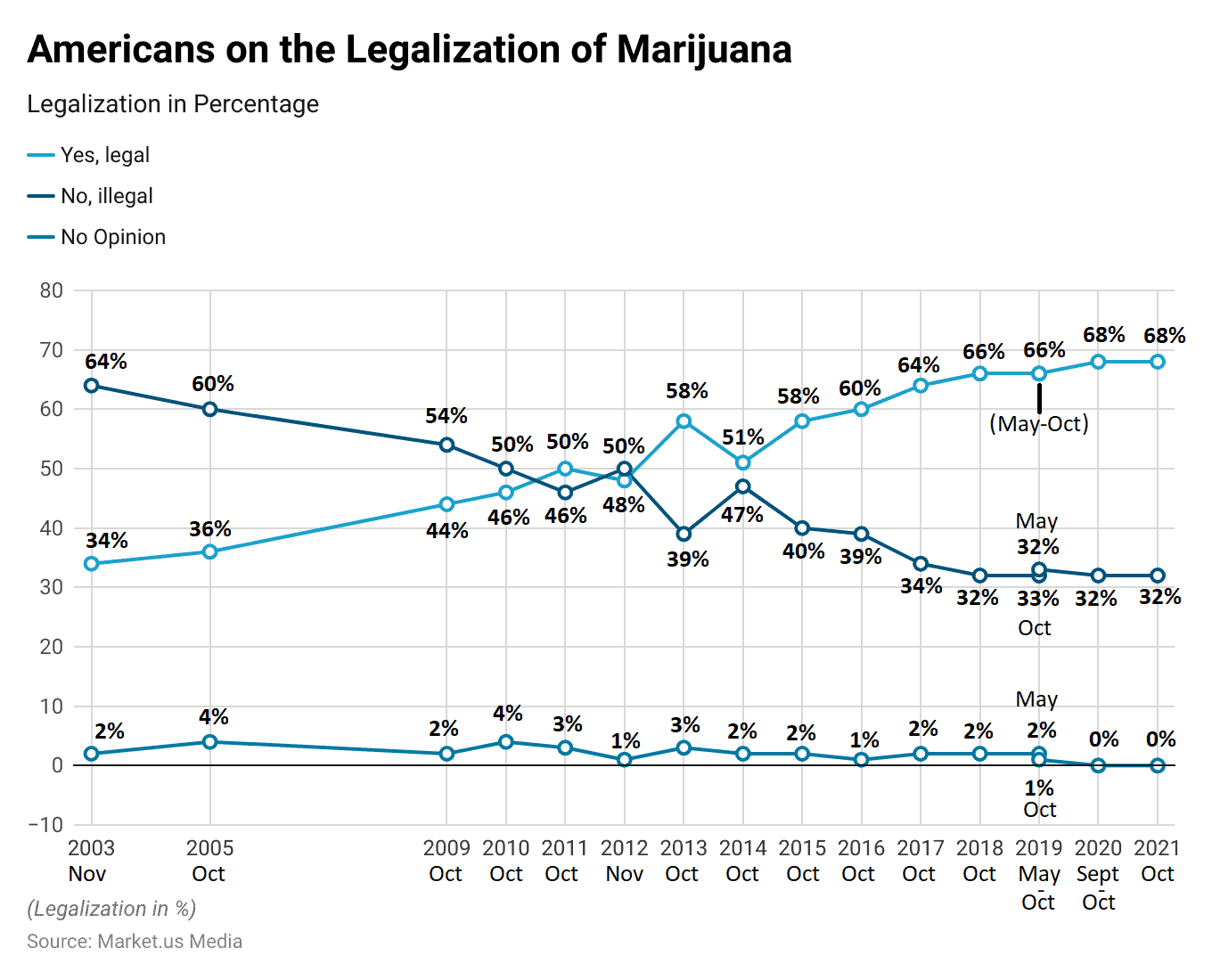
Support for Legalizing Marijuana
- Support for the legalization of marijuana among U.S. adults has seen a significant increase from 1969 to 2023.
- In 1969, only 12% of respondents were in favor of legalization. This figure rose to 16% in 1973 and then to 26% in 1977.
- The support fluctuated slightly in the following years, standing at 25% in 1980, 23% in 1985, and returning to 25% in 1995.
- By 2000, support had grown to 31%, and it continued to rise steadily, reaching 36% in 2005 and 44% in 2010.
- A notable shift occurred in 2012 when support reached 50%. Marking the first time that half of the respondents favored legalization.
- This upward trend continued, with support increasing to 58% in 2013 and 2015, 64% in 2017, and 66% in 2018 and 2019.
- By 2020, 68% of respondents supported legalization, a level of support that remained constant through 2021 and 2022.
- In 2023, support for legalizing marijuana among U.S. adults reached a new high of 70%.
- This data reflects a growing acceptance and changing attitudes toward marijuana legalization over the past five decades.
(Source: Statista)
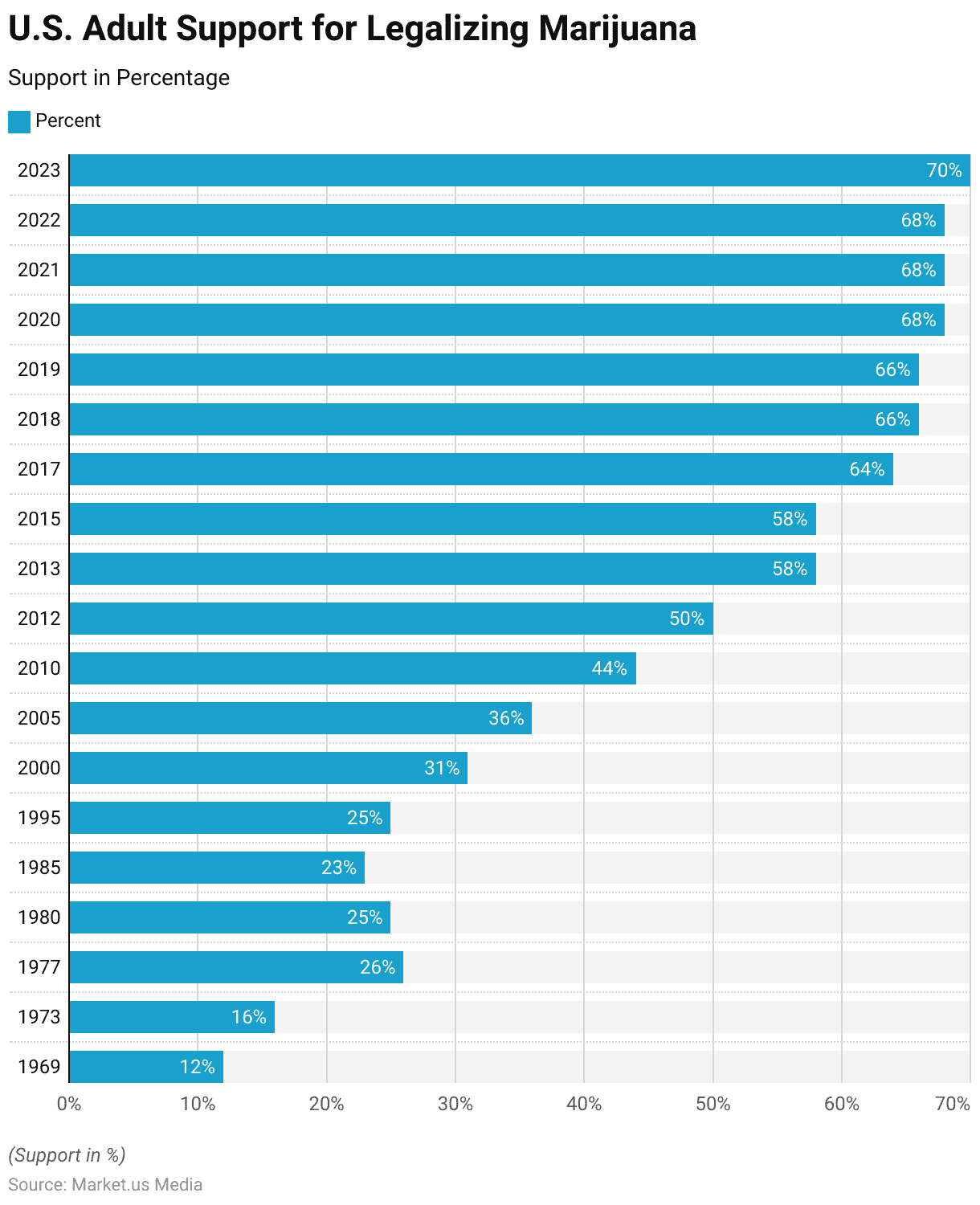
Key Investments
- From 2016 to 2021, the share of cannabis investment deals worldwide has shown notable changes in terms of deal size.
- In 2016, a significant majority, 97.5%, of the deals were valued between $0 and $50 million. While 1.3% fell within the $50-$500 million range and 1.2% exceeded $500 million.
- The following year, in 2017, the proportion of smaller deals slightly decreased to 97.3%. With mid-sized deals increasing to 2.7% and no deals exceeding $500 million.
- In 2018, the share of deals valued at $0-$50 million dropped to 89.6%, as the percentage of deals in the $50-$500 million range rose to 9.4%, and 1% of deals were greater than $500 million.
- This trend continued in 2019, with the smallest deals representing 87.5% of the total, mid-sized deals increasing to 10.9%, and 1.6% of deals exceeding $500 million.
- The year 2020 saw a slight reversal, with 92.8% of deals in the $0-$50 million range, 6.5% in the $50-$500 million range, and 0.7% exceeding $500 million.
- By 2021, the trend towards larger deals became more pronounced, with only 83.6% of deals valued at $0-$50 million, 15.1% at $50-$500 million, and 1.3% exceeding $500 million.
- This data indicates a gradual shift towards larger cannabis investment deals over these six years.
(Source: Statista)
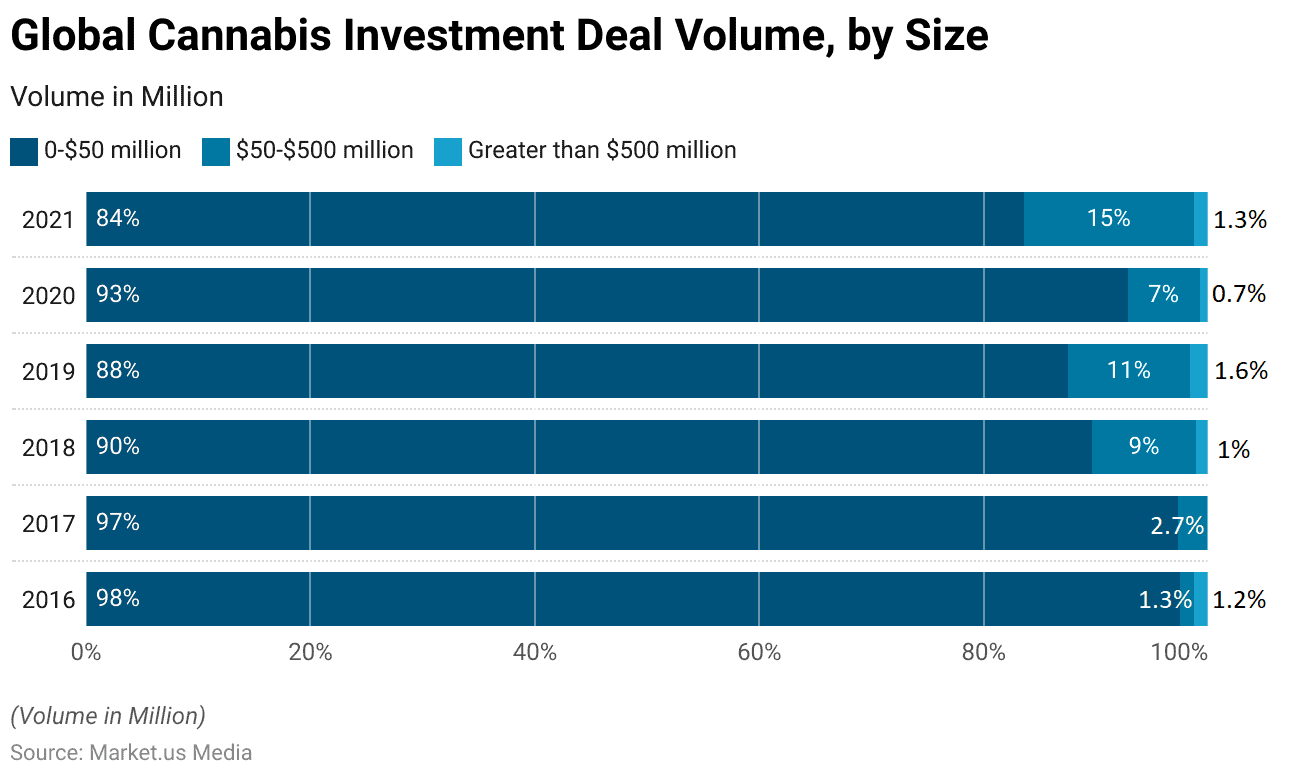
Regulations for Medical Marijuana
- The regulations for medical marijuana vary significantly across different countries.
- In the United States, medical marijuana is legal in 38 states and several territories. It remains federally classified as a Schedule I substance, complicating nationwide standardization.
- Canada and Uruguay are unique in that they have federally legalized both medical and recreational use. With Canada implementing a provincial framework for regulation.
- European countries such as Germany, Italy, and the U.K. have established medical marijuana programs, permitting the use of cannabis-based medicines.
- In South America, countries like Argentina, Brazil, and Colombia have legalized medical marijuana. With regulatory frameworks focusing on licensing and prescription protocols.
- In the Asia-Pacific region, Australia and New Zealand have comprehensive medical marijuana programs. Whereas countries like Thailand have recently begun to develop their regulatory structures.
- Africa‘s regulatory landscape is emerging, with nations like South Africa and Zimbabwe legalizing medical use under strict conditions.
- Each country’s approach is influenced by its legal, cultural, and political context, affecting everything from production to prescription practices.
(Sources: Cann Intelligence, KIF, The Marijuana Herald)
Recent Developments
Acquisitions and Mergers:
- Curaleaf acquires EMMAC Life Sciences: In early 2023, Curaleaf, a leading medical marijuana company, completed its acquisition of EMMAC Life Sciences for $286 million. This acquisition aims to expand Curaleaf’s footprint in Europe, enhancing its position as a global leader in the medical marijuana market.
- Aphria merges with Tilray: In mid-2023, Aphria and Tilray, two major players in the medical marijuana industry, merged in a deal valued at $4 billion. This merger is expected to create the world’s largest cannabis company by revenue, combining their extensive product portfolios and market reach.
New Product Launches:
- Canopy Growth’s Spectrum Therapeutics Line: In early 2024, Canopy Growth launched a new line of medical marijuana products under the Spectrum Therapeutics brand. These products are designed to cater to various medical conditions and include oils, capsules, and topical solutions.
- Aurora Cannabis’s CBD Oil: Aurora Cannabis introduced a new high-potency CBD oil in mid-2023, targeting patients seeking relief from chronic pain, anxiety, and other medical conditions. This product is part of Aurora’s efforts to expand its medical marijuana offerings.
Funding:
- GW Pharmaceuticals raises $250 million: In 2023, GW Pharmaceuticals, known for its cannabis-based medications, raised $250 million in a funding round to support the development of new treatments and expand its clinical trials for medical marijuana products.
- Charlotte’s Web secures $75 million: Charlotte’s Web, a leading CBD company, secured $75 million in early 2024 to invest in R&D, enhance its product line, and expand its distribution network in the medical marijuana market.
Technological Advancements:
- Genetic Engineering for Enhanced Strains: Advances in genetic engineering are being used to develop new marijuana strains with higher concentrations of therapeutic compounds. Improved efficacy, and tailored effects for specific medical conditions.
- Blockchain for Supply Chain Transparency: The development of blockchain technology is being applied to the medical marijuana supply chain to ensure product authenticity, traceability, and compliance with regulatory standards, enhancing consumer trust.
Market Dynamics:
- Growth in Medical Marijuana Market: The global medical marijuana market is projected to grow at a CAGR of 17.8% from 2023 to 2028, driven by increasing legalization. Rising acceptance of cannabis for medical use, and advancements in cannabis research.
- Rising Demand for CBD Products: There is a significant increase in demand for CBD-based medical marijuana products due to their non-psychoactive properties and potential therapeutic benefits, contributing to market growth.
Regulatory and Strategic Developments:
- US FDA Approves Epidiolex for New Indications: In early 2024, the US Food and Drug Administration (FDA) approved Epidiolex, a CBD-based drug, for additional indications. Including treatment of tuberous sclerosis complex. This approval is expected to drive the adoption of medical marijuana in mainstream healthcare.
- European Union’s Medical Cannabis Legislation: The European Union updated its medical cannabis legislation in 2023 to streamline the approval process for new cannabis-based medications. Ensuring patient safety and promoting innovation in the medical marijuana sector.
Research and Development:
- Clinical Trials for New Therapeutic Uses: R&D efforts are focusing on conducting clinical trials to explore new therapeutic uses of medical marijuana, including treatments for neurological disorders, cancer-related symptoms, and autoimmune diseases.
- Nano-Emulsion Technology: Researchers are developing nano-emulsion technology to enhance the bioavailability and efficacy of medical marijuana products, allowing for faster onset of action and improved therapeutic outcomes.
Conclusion
Medical Marijuana Statistics – The medical marijuana market has seen dynamic growth and significant evolution. Driven by changing legal landscapes and growing recognition of its therapeutic benefits.
Moreover, the global market value is projected to continue expanding, with North America as the dominant region and emerging opportunities in Europe and Asia-Pacific.
Patient demographics show diverse age groups, primarily middle-aged and older adults. Major pharmaceutical companies and specialized cannabis firms indicate robust investment and innovation.
However, consumption methods are diversifying, with a trend towards higher-value investment deals reflecting increasing investor confidence.
The medical marijuana market’s potential to improve patient outcomes and contribute to economic growth underscores its significance in the global healthcare landscape.
FAQs
Medical marijuana refers to the use of the Cannabis plant or its extracts for treating health conditions. Healthcare providers prescribe it for various therapeutic benefits.
Medical marijuana is commonly used to alleviate symptoms associated with chronic pain, multiple sclerosis, epilepsy, cancer, glaucoma, PTSD, severe nausea, and muscle spasms, among others.
The legality of medical marijuana varies by country and, in the U.S., by state. Some regions have fully legalized its use, while others have strict regulations or have not legalized it at all.
Medical marijuana can be consumed in various forms, including smoking, vaporizing, ingesting edibles, using oils, applying topicals, and through tinctures.
Common side effects may include dizziness, dry mouth, altered mental state, fatigue, and changes in appetite. Using it under medical supervision is essential to manage potential side effects.
Discuss your needs with our analyst
Please share your requirements with more details so our analyst can check if they can solve your problem(s)



